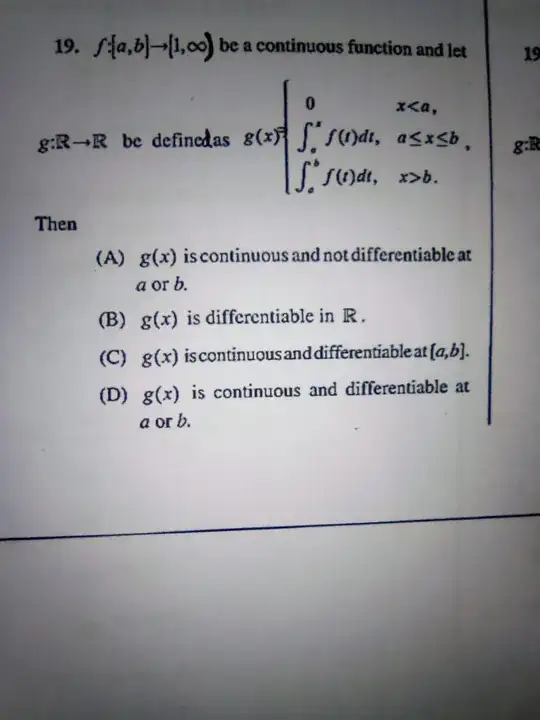Below is my working:
CONTINUITY AT $x=a$
*$\lim_{x\to a^-}g(x)=\lim_{h\to0}g(a-h)=0$
*$\lim_{x\to a^+}g(x)=\lim_{h\to0}g(a+h)=\lim_{h\to0}\int_{a}^{a+h}f(t)dt=\int_{a}^{a}f(t)dt=0$
*$g(a)=\int_{a}^{a}f(t)dt=0$
Therefore $g(x)$ is continuous at $x=a$
CONTINUITY AT $x=b$
*$\lim_{x\to b^-}g(x)=\lim_{h\to0}g(b-h)=\lim_{h\to0}\int_{a}^{b-h}f(t)dt=\int_{a}^{b}f(t)dt$
*$\lim_{x\to b^+}g(x)=\lim_{h\to0}g(b+h)=\lim_{h\to0}\int_{a}^{b}f(t)dt=\int_{a}^{b}f(t)dt$
*$g(b)=\int_{a}^{b}f(t)dt$
Therefore $g(x)$ is continuous at $x=b$
CONTINUITY AT $x=k\in (a,b)$
*$\lim_{x\to k^-}g(x)=\lim_{h\to0}g(k-h)=\lim_{h\to0}\int_{a}^{k-h}f(t)dt=\int_{a}^{k}f(t)dt$
*$\lim_{x\to k^+}g(x)=\lim_{h\to0}g(k+h)=\lim_{h\to0}\int_{a}^{k+h}f(t)dt=\int_{a}^{k}f(t)dt$
*$g(k)=\int_{a}^{k}f(t)dt$
CONTINUITY AT $x=k<a$ and $x=k>b$
It can be shown in a similar way that $g(x)$ is continuous at $x=k<a$ and $x=k>b$
DIFFERENTIABILITY AT $x=a$
*$\lim_{x\to a^-}\frac{g(x)-g(a)}{x-a}=\lim_{h\to 0}\frac{g(a-h)-g(a)}{-h}=\lim_{h\to 0}\frac{0}{h}=0$
*$\lim_{x\to a^+}\frac{g(x)-g(a)}{x-a}=\lim_{h\to 0}\frac{g(a+h)-g(a)}{h}=\lim_{h\to 0}\frac{\int_{a}^{a+h}f(t)dt-0}{h}=\lim_{h\to 0}\frac{\frac{d}{dh}\int_{a}^{a+h}f(t)dt}{1}=\lim_{h\to 0}f(a+h)=f(a)=0$
Therefore $g(x)$ is differentiable at $x=a$
DIFFERENTIABILITY AT $x=b$
*$\lim_{x\to b^-}\frac{g(x)-g(b)}{x-b}=\lim_{h\to 0}\frac{g(b-h)-g(b)}{-h}=\lim_{h\to 0}\frac{\int_{a}^{b-h}f(t)dt-\int_{a}^{b}f(t)dt}{-h}=\lim_{h\to 0}\frac{\frac{d}{dh}\int_{a}^{b-h}f(t)dt-0}{-1}=\lim_{h\to 0}f(b-h)=f(b)=\int_{a}^{b}f(t)dt$
*$\lim_{x\to b^+}\frac{g(x)-g(b)}{x-b}=\lim_{h\to 0}\frac{g(b+h)-g(b)}{h}=\lim_{h\to 0}\frac{\int_{a}^{b}f(t)dt-\int_{a}^{b}f(t)dt}{h}=\lim_{h\to 0}\frac{0}{h}=\lim_{h\to 0}0=0$
Therefore $g(x)$ is not differentiable at $x=b$
DIFFERENTIABILITY AT $x=k\in(a,b)$
*$\lim_{x\to k^-}\frac{g(x)-g(k)}{x-k}=\lim_{h\to 0}\frac{g(k-h)-g(k)}{-h}=\lim_{h\to 0}\frac{\int_{a}^{k-h}f(t)dt-\int_{a}^{k}f(t)dt}{-h}=\lim_{h\to 0}\frac{\frac{d}{dh}\int_{a}^{k-h}f(t)dt-0}{-1}=\lim_{h\to 0}f(k-h)=f(k)=\int_{a}^{k}f(t)dt$
*$\lim_{x\to k^+}\frac{g(x)-g(k)}{x-k}=\lim_{h\to 0}\frac{g(k+h)-g(k)}{h}=\lim_{h\to 0}\frac{\int_{a}^{k+h}f(t)dt-\int_{a}^{k}f(t)dt}{h}=\lim_{h\to 0}\frac{\frac{d}{dh}\int_{a}^{k+h}f(t)dt-0}{1}=\lim_{h\to 0}f(k+h)=f(k)=\int_{a}^{k}f(t)dt$
Therefore $g(x)$ is differentiable in $(a,b)$
DIFFERENTIABILITY AT $x=k<a$ and $x=k>b$
Similarly it can be shown that $g(x)$ is differentiable at $x=k<a$ and $x=k>b$
Am I correct? Is there any short way to solve this?
